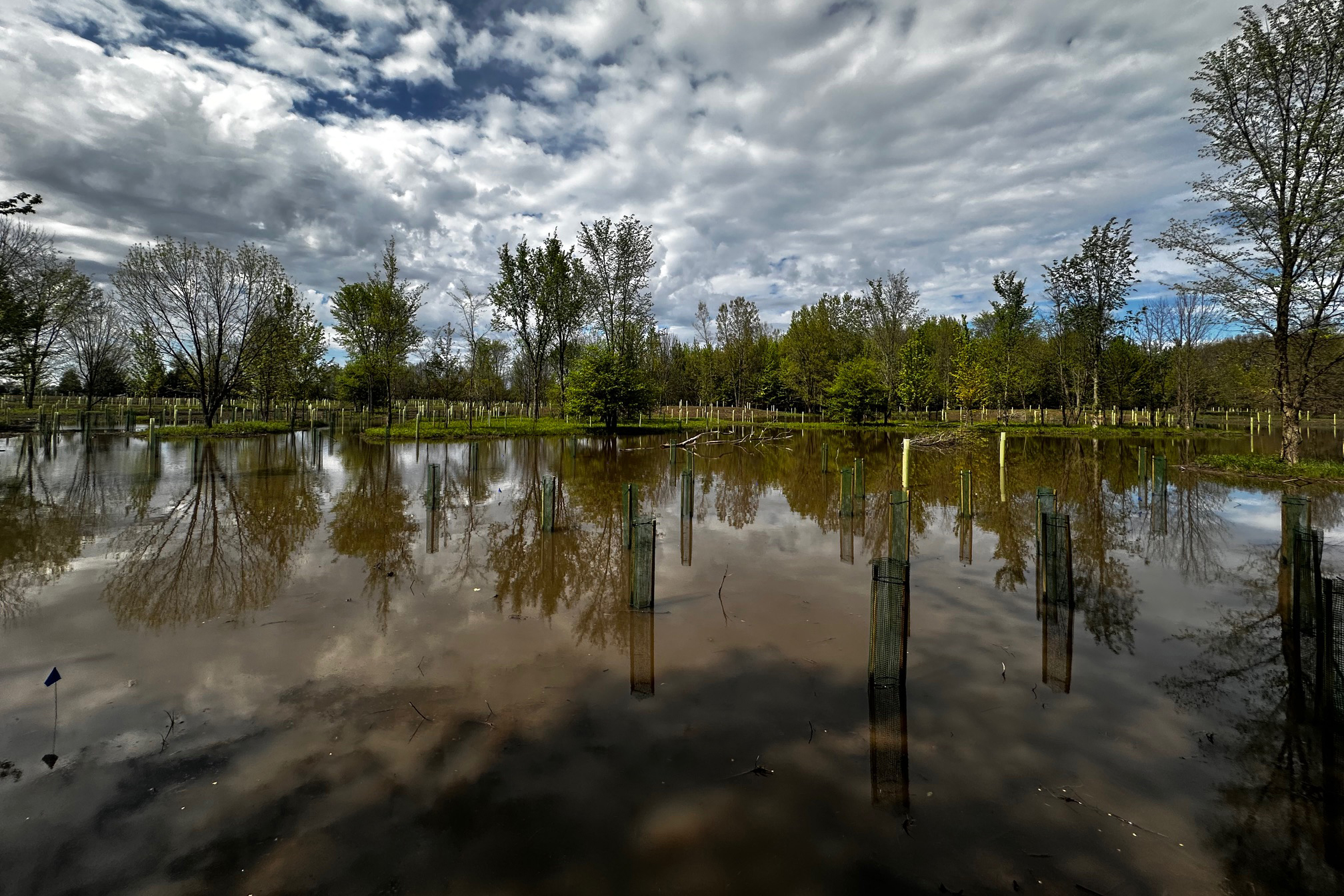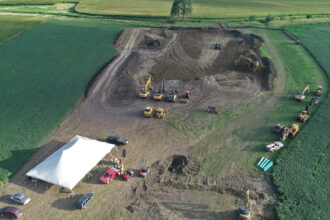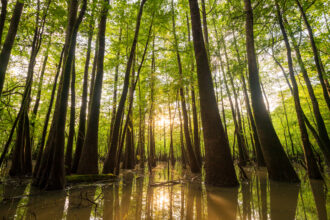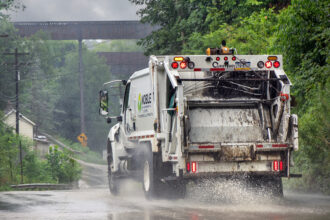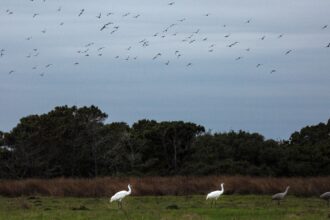A new report on purpose-built wetlands in Ohio showcases their success in reducing nutrient runoff from farms, validating millions of dollars’ worth of efforts to combat toxic algal blooms.
Researchers with the H2Ohio Wetland Monitoring Program developed the report, which uses data from 10 wetlands that have been restored since the H2Ohio program launched in 2019. The scientists found each wetland retained more nutrients than it released, easing concerns that the opposite might be occurring. The team also collected novel data on how plants may impact nutrient retention—a largely unexplored topic that could shape future wetland projects.
Each H2Ohio wetland was built with a common goal: to capture phosphorus and nitrogen that leach from farmland before they reach Lake Erie and become food for toxic algae. They vary immensely in size and style—for example, some rely on naturally flowing water, while others include active pump systems. Researchers aimed to survey several types of wetlands to help identify best practices for restoration, which is still a relatively young field.
“We don’t know of any other program nationally or globally that looks at so many different kinds of projects … under a similar umbrella,” said Lauren Kinsman-Costello, the principal research lead for the monitoring program and a biogeochemist at Kent State University. “It’s been a real challenge because … we’ve had to develop very specific, different approaches to get to that final number [of nutrients captured].”
While every wetland featured in the report retained nutrients, the specific results varied significantly. Kinsman-Costello said the outcomes were different because of the unique terrain and design of each project.
On the whole, the most effective wetlands are those built on former agricultural land, Kinsman-Costello said. These wetlands turn that land from a nutrient emitter into a nutrient sink.
“If it’s in the right place and it has the right features, it can really punch above its weight,” she said.
She said it doesn’t take much land to make a big impact. The wetlands in the report range from 5 to 173 acres in area.
“This isn’t saying that large-scale agricultural land should be converted to wetlands, right? This is very much, find the locations and times of opportunity where that conversion makes the most sense,” Kinsman-Costello said.
It’s also best when wetlands have a direct connection to an external nutrient source—in other words, a body of water carrying large amounts of nutrients downstream.
“We think of wetlands as the kidneys of the landscape,” Kinsman-Costello said. “Well, they can’t really be kidneys if they aren’t connected to all of the contaminants or pollutants that they’re meant to filter out.”
Angela Burrow, an assistant professor of wetland ecology and management at Michigan State University who was not involved in the research, said the report did a “great job at looking at how different practices in restoration can be impactful.”
“There’s really not a lot of research that’s done on restoration generally, and certainly not a lot for wetland restoration. It’s often a practice, but there’s not a lot of information about what are best practices?” Burrow said.
According to Burrow, that’s been an issue since the contemporary environmental movement developed in the 1970s.
“Initially it was just, ‘Plant the native plants and everything will be fine.’ And so obviously, that isn’t the greatest way to design something that’s going to last long term, or meet the functions and services that we want it to,” Burrow said.
Wetlands in particular are ripe for further investigation. While they often look like natural spaces, many have in fact been carefully engineered by humans. They are natural ecosystems, but they are also purpose-built instruments to change what’s in the water and how that water moves over land.
“There are a lot of technical, industry-driven practices, private sector innovations that contribute considerably,” Kinsman-Costello said. She hopes the H2Ohio program can eventually become a kind of lab for these new ideas.
One of the key design challenges for many wetlands is ensuring they reliably capture nutrients regardless of the weather. For example, a “side-channel” wetland sits adjacent to a river, with a barrier separating it. When the river rises high enough, the water overflows the barrier and the wetland collects the water. That requires a certain amount of rainfall, so in a drought year the wetland may divert less water and capture fewer nutrients. Kinsman-Costello said an active water-control system, such as a pump, can help, though it is more expensive.
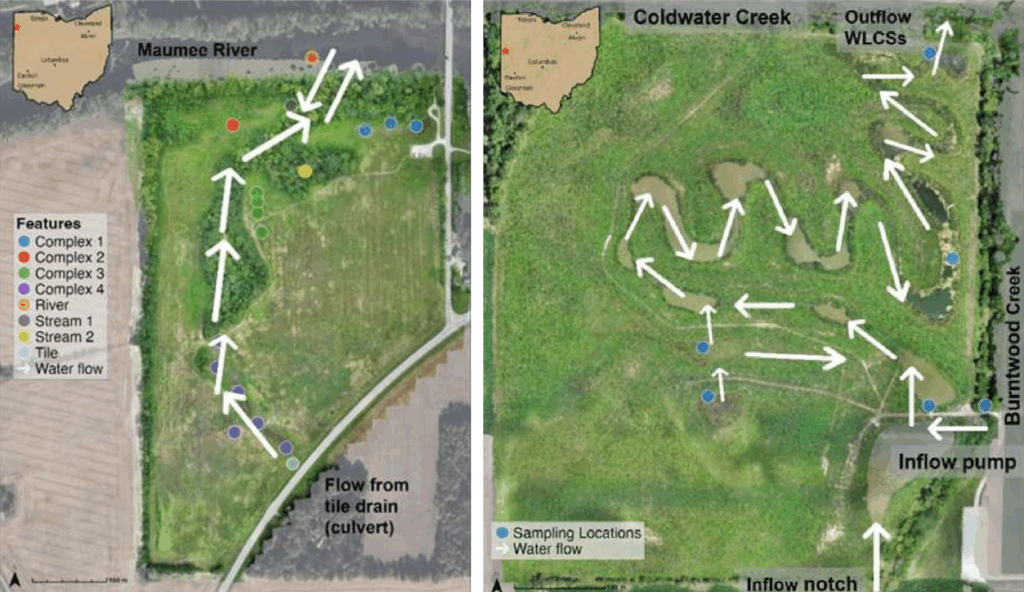
This year’s report also includes a brand-new focus on native plants, whose functioning in wetlands is not well understood. Wetland managers buy native seed mixes for new wetlands, but nutrient capture isn’t typically a factor they consider, according to Kevin McCluney, a lead researcher on the report’s vegetation monitoring team and a scientist at Bowling Green State University. There just isn’t much data on how well different native plants absorb nutrients.
To figure that out, the vegetation monitoring team had to determine how much biomass wetland plants were storing underground. That included understanding their root systems. The team developed its own sampling method, which involved collecting 20 cm-deep soil samples and filtering out the roots, some of which were only a millimeter thick. McCluney said it took up to an hour to collect a single sample, and another two hours or more to process it.
The results were promising for some native plant species, according to vegetation research coordinator Lauren Brown, also of Bowling Green. Although there’s a common assumption in restoration that invasives like cattail “are doing the heavy lifting of capturing nutrients” because they grow so aggressively, some natives appear to perform just as well.
“Our data is really showing that you don’t have to sacrifice diversity in favor of the nutrient capture,” Brown said.
This story is funded by readers like you.
Our nonprofit newsroom provides award-winning climate coverage free of charge and advertising. We rely on donations from readers like you to keep going. Please donate now to support our work.
Donate NowOutside the H2Ohio monitoring program, McCluney said the same researchers are also looking at how well different wetland plants adapt to weather extremes, such as the drought that gripped Ohio in 2024. That experiment is ongoing, but preliminary observations indicate native soft rush might thrive in drought conditions while also absorbing significant nutrients.
“That could be something that you really want in your seed mix if you expect to have more of those drought years,” McCluney said.
Future Research Holds Promise, but Funding Is Becoming Scarcer
Although the report contains many promising findings, Kinsman-Costello noted that the program has generated only two years of data overall.
“These are brand new baby wetlands … some of them barely have plants growing in them,” Kinsman-Costello said. “Our top priority is to maintain the monitoring and the expertise that we’ve built … to continue seeing how these new constructed novel systems evolve and how they respond under varying conditions from year to year.”
One of the biggest questions is whether these wetlands will continue acting as nutrient sinks as they mature, or whether they might eventually start leaking phosphorus.
“Based on the basics of biogeochemistry and how phosphorus works, that’s always going to be a risk,” Kinsman-Costello said. “Some kind of long-term assessment or monitoring of these systems … is going to be necessary to ensure that that retention continues.”
Another area Kinsman-Costello said she’s hoping future research will cover is carbon storage. Wetlands are effective at storing carbon, but also potent methane emitters. It’s not yet clear how those balance out.
“We’ve built a foundation with some of the samples we’ve archived, some of the data we’ve already collected, that we could build on in the future to more directly assess that full range of what I call biogeochemical functions,” Kinsman-Costello said.
The native plant research also has significant room to grow. For example, it remains to be seen how much those tiny root systems grow as the wetlands ages.
“That’s a big unresolved question,” McCluney said. “How long does that take to really accumulate those below-ground storage structures that can store nutrients for multiple years?”
Another ongoing question is how different plant species affect oxygen levels in the soil. The more oxygen there is in soil, the more phosphorus that can be trapped. Conversely, anoxic soil can cause phosphorus to dissolve and re-enter the water.
All this additional research may have suffered a significant setback in Ohio’s latest biennial budget, in which the state legislature cut H2Ohio’s wetland funding by over half, from $46.6 million to $21.2 million. It remains to be seen how much of that ends up coming out of the wetland program’s research budget.
McCluney said the monitoring program will need additional funds on Jan. 1, 2026 to continue operating.
“We do believe that that will be possible, but we don’t know yet to what level,” he said.
The Ohio Department of Natural Resources, which oversees the H2Ohio wetland program, confirmed that the monitoring program will receive less money from the state going forward.
Kinsman-Costello said the researchers are actively pursuing other funding sources and expressed confidence that the work will continue.
“We’re constantly talking to the land trusts, the municipalities, the metro park systems that are the managers of these projects and the consulting firms that are designing the process,” Kinsman-Costello said.
She added that new research opportunities are still coming up—for example, beaver dam analogs and micro topography installations.
“There’s a long list of dozens of very specific practices that can be incorporated into wetland design that we’d love to evaluate in a scientific way now that we have this baseline,” she said.
About This Story
Perhaps you noticed: This story, like all the news we publish, is free to read. That’s because Inside Climate News is a 501c3 nonprofit organization. We do not charge a subscription fee, lock our news behind a paywall, or clutter our website with ads. We make our news on climate and the environment freely available to you and anyone who wants it.
That’s not all. We also share our news for free with scores of other media organizations around the country. Many of them can’t afford to do environmental journalism of their own. We’ve built bureaus from coast to coast to report local stories, collaborate with local newsrooms and co-publish articles so that this vital work is shared as widely as possible.
Two of us launched ICN in 2007. Six years later we earned a Pulitzer Prize for National Reporting, and now we run the oldest and largest dedicated climate newsroom in the nation. We tell the story in all its complexity. We hold polluters accountable. We expose environmental injustice. We debunk misinformation. We scrutinize solutions and inspire action.
Donations from readers like you fund every aspect of what we do. If you don’t already, will you support our ongoing work, our reporting on the biggest crisis facing our planet, and help us reach even more readers in more places?
Please take a moment to make a tax-deductible donation. Every one of them makes a difference.
Thank you,

